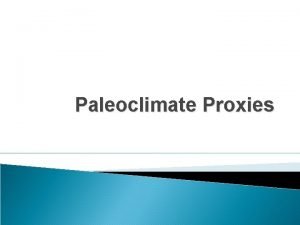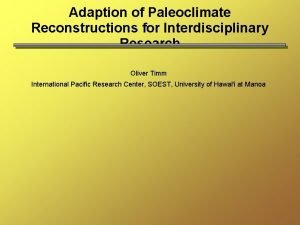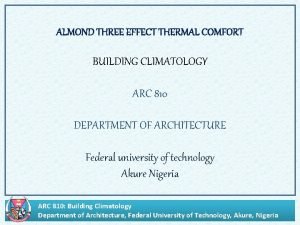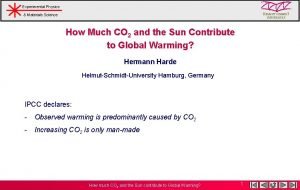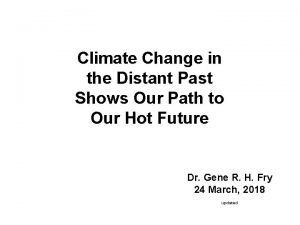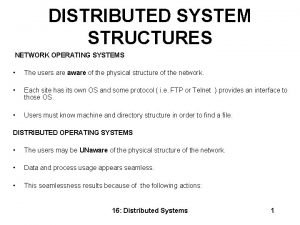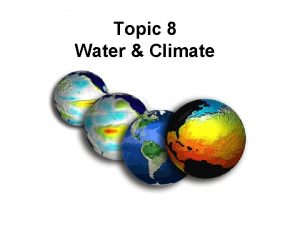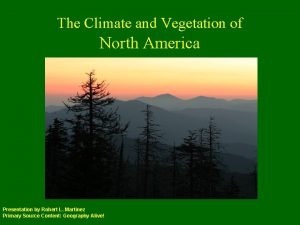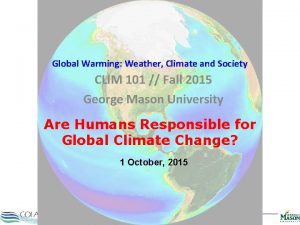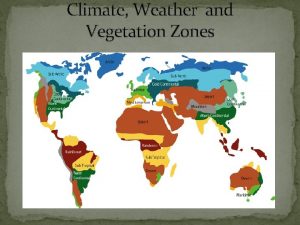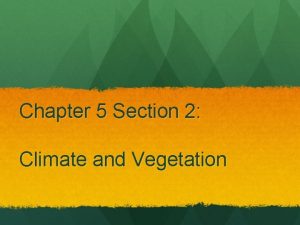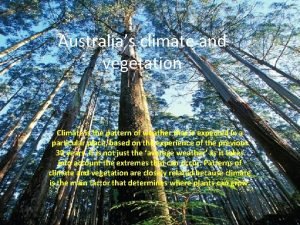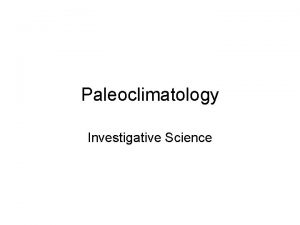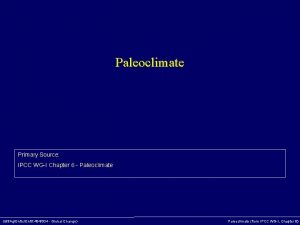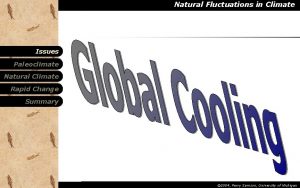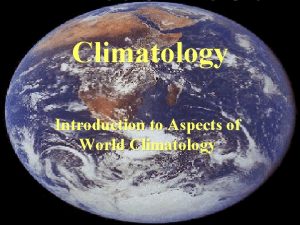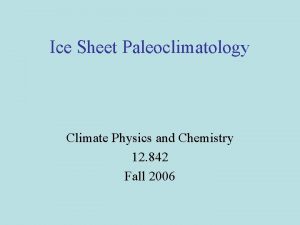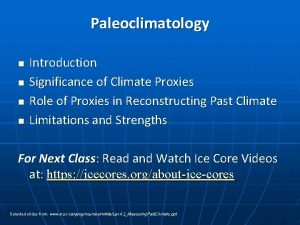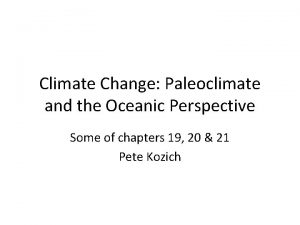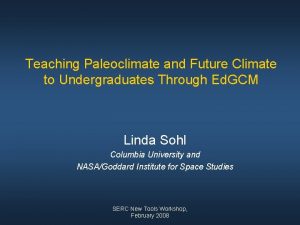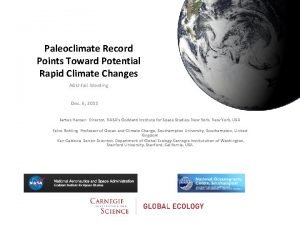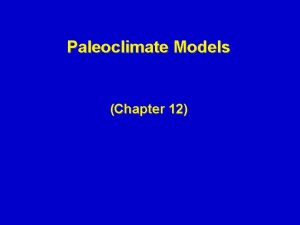Climatology and Paleoclimatology Issues Structure Paleoclimate Climate Summary























- Slides: 23

Climatology and Paleoclimatology Issues Structure Paleoclimate Climate Summary © 2003, Perry Samson, University of Michigan

Climatology and Paleoclimatology Distribution of Air Issues Percent of Atmosphere Structure with Altitude Paleoclimate Climate Summary © 2003, Perry Samson, University of Michigan

Climatology and Paleoclimatology Issues Structure Paleoclimate Climate Summary © 2003, Perry Samson, University of Michigan

Climatology and Paleoclimatology Density Issues Structure Atmospheric density is a measure of the mass of air molecules per volume of atmosphere. Paleoclimate Climate Summary © 2003, Perry Samson, University of Michigan

Climatology and Paleoclimatology Issues Structure Paleoclimate Climate Summary © 2003, Perry Samson, University of Michigan

Climatology and Paleoclimatology The Structure of the Atmosphere Issues Pressure Structure Paleoclimate Climate Summary Temperature Force exerted per unit area. In most sciences the standard unit of measure is the pascal (Pa), but in meteorology either millibar (1 mb = 100 Pa) or inches of Mercury (in Hg = 3386 Pa) are used. A measure of the average kinetic energy of the molecules comprising a substance. © 2003, Perry Samson, University of Michigan

Climatology and Paleoclimatology The Structure of the Atmosphere Issues Pressure Force exerted per unit area. In most sciences the standard unit of measure is the pascal (Pa), but in meteorology either millibar (1 mb = 100 Pa) or inches of Mercury (in Hg = 3386 Pa) are used. Temperature A measure of the average kinetic energy of the molecules comprising a substance. Structure Paleoclimate Climate Summary © 2003, Perry Samson, University of Michigan

Climatology and Paleoclimatology Thermosphere Issues Structure Paleoclimate Climate Summary • The thermosphere is the fourth layer of the Earth's atmosphere and is located above the mesosphere. • The air is extremely thin in thermosphere. A small change in energy can cause a large change in temperature. • When the sun is active, thermosphere can heat up to 1, 500°C or higher. • The Earth's thermosphere also includes the region of the atmosphere called the ionosphere. The ionosphere is a region of the atmosphere that is filled with charged particles. © 2003, Perry Samson, University of Michigan

Climatology and Paleoclimatology Mesosphere Issues Structure Paleoclimate Climate In the Earth's mesosphere, the air is relatively mixed together and the temperature decreases with altitude. The atmosphere reaches its coldest temperature of around 90°C in the mesosphere. This is also the layer in which a lot of meteors burn up while entering the Earth's atmosphere. Summary © 2003, Perry Samson, University of Michigan

Climatology and Paleoclimatology Stratosphere Issues Structure In the Earth's stratosphere, the temperature increases with altitude. On Earth, ozone causes the increasing temperature in the stratosphere. Paleoclimate Climate Summary Ozone is concentrated around an altitude of 25 kilometers in the “ozone layer. ” The ozone molecules absorb dangerous kinds of sunlight, which heats the air around them. © 2003, Perry Samson, University of Michigan

Climatology and Paleoclimatology Troposphere Issues Structure The troposphere is the layer in contact with the Earth’s surface and hence its temperature structure is predicated by energy transmitted to and from the surface. Paleoclimate Climate Summary © 2003, Perry Samson, University of Michigan

Climatology and Paleoclimatology Oxygen Isotopes Issues Structure 16 O: 99. 8% of Oxygen 18 O: 0. 2% of Oxygen Paleoclimate Climate Summary parts per thousand © 2003, Perry Samson, University of Michigan

Climatology and Paleoclimatology Oxygen Isotopes Issues Structure Paleoclimate Climate Summary © 2003, Perry Samson, University of Michigan

Climatology and Paleoclimatology Redistribution of oxygen isotopes: Issues Paleoclimatology Interglacial Structure Paleoclimate Climate Summary © 2003, Perry Samson, University of Michigan

Climatology and Paleoclimatology Redistribution of oxygen isotopes: Issues Structure Paleoclimate Climate Glacial Paleoclimatology 18 O in precipitation increases with increasing temperatures Summary © 2003, Perry Samson, University of Michigan

Climatology and Paleoclimatology Oxygen Isotopes Issues Structure Paleoclimate Climate Summary For each 4. 2°C increase in ocean temperature the 18 O ratio decreases by 1 o/oo © 2003, Perry Samson, University of Michigan

Climatology and Paleoclimatology Sintering: Air Issues Structure Paleoclimate Climate Summary moves freely through snow and ice in the first 15 m of an ice sheet, but movement is restricted below this with air bubbles eventually sealed off completely about 50 -100 m below the surface. © 2003, Perry Samson, University of Michigan

Climatology and Paleoclimatology Issues Changes in CO 2 (0 - 450, 000 YBP) Structure Paleoclimate Vostok NOW Climate Summary © 2003, Perry Samson, University of Michigan

Climatology and Paleoclimatology Issues Structure Paleoclimate Vostok Climate Summary © 2003, Perry Samson, University of Michigan

Climatology and Paleoclimatology Enhanced fertilization theory Issues Structure Paleoclimate Climate Summary © 2003, Perry Samson, University of Michigan

Climatology and Paleoclimatology Biological Pump Atmospheric Deposition Issues Structure CO 2 Paleoclimate CO 2 Biomass Conversion Summary Riverine Deposition Upwelling Burial in Sediments © 2003, Perry Samson, University of Michigan

Climatology and Paleoclimatology Feedback Mechanism: Biological Pump Issues Global surface temperature Structure Paleoclimate Climate Atmospheric CO 2 Glacial ice volume Equator-to-pole temperature gradient Summary Sea level East-west wind speed Intensity of biological pump Shelf exposure Wind-borne flux of iron Oceanic concentration of phosphate Riverine flux of phosphate © 2003, Perry Samson, University of Michigan

Climatology and Paleoclimatology Lessons from Vostok Issues Structure Paleoclimate Climate Summary 1. Past changes in climate have often been triggered by changes in orbital characteristics. 2. These initial changes are then amplified by changes in CO 2 and CH 4 concentrations through changes in the “biological pump”. 3. The changes in greenhouse gas concentrations then exaggerate the temperature changes over the earth. © 2003, Perry Samson, University of Michigan
 Paleoclimate proxy examples
Paleoclimate proxy examples Paleoclimate proxies
Paleoclimate proxies Thermal comfort chart
Thermal comfort chart Helmut schmidt universität
Helmut schmidt universität International satellite cloud climatology project
International satellite cloud climatology project Climate change 2014 mitigation of climate change
Climate change 2014 mitigation of climate change What are design issues in distributed system structure
What are design issues in distributed system structure Legal ethical and societal issues
Legal ethical and societal issues E commerce security and fraud issues and protections
E commerce security and fraud issues and protections Legal and ethical issues in computer security
Legal and ethical issues in computer security Zones de vegetation du canada
Zones de vegetation du canada Infiltration water cycle
Infiltration water cycle Vegetation of north america
Vegetation of north america Scandinavian climate and geography
Scandinavian climate and geography How does wind affect weather and climate
How does wind affect weather and climate Clim 101
Clim 101 How do prevailing winds affect climate
How do prevailing winds affect climate Which colonial region contained rocky soil and cold climate
Which colonial region contained rocky soil and cold climate Climate and vegetation zones
Climate and vegetation zones Climate change meaning and definition
Climate change meaning and definition Chapter 15 section 2 climate and vegetation
Chapter 15 section 2 climate and vegetation Why is the middle east so dry
Why is the middle east so dry Australia climate and vegetation
Australia climate and vegetation Chapter 13 atmosphere and climate change section 1
Chapter 13 atmosphere and climate change section 1
